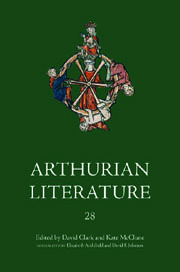Book contents
- Frontmatter
- Contents
- General Editors' Foreward
- Preface
- List of Contributors
- Abbreviations
- I Reading Malory's Bloody Bedrooms
- II (Dis)Figuring Transgressive Desire: Blood, Sex, and Stained Sheets in Malory's Morte Darthur
- III Bewmaynes: the threat from the kitchen
- IV Sibling Relations in Malory's Morte Darthur
- V ‘Traytoures’ and ‘Treson’: the Language of Treason in the Works of Sir Thomas Malory
- VI ‘The Vengeaunce of My Brethirne’: Blood Ties in Malory's Morte Darthur
- VII Malory and the Scots
- VIII Blood, Faith and Saracens in ‘The Book of Sir Tristram’
- IX Barriers Unbroken: Sir Palomydes the Saracen in ‘The Book of Sir Tristram’
- X Virginity, Sexuality, Repression and Return in the ‘Tale of the Sankgreal’
- XI Launcelot in Compromising Positions: Fabliau in Malory's ‘Tale of Sir Launcelot du Lake’
- Title in the Series
III - Bewmaynes: the threat from the kitchen
Published online by Cambridge University Press: 05 February 2013
- Frontmatter
- Contents
- General Editors' Foreward
- Preface
- List of Contributors
- Abbreviations
- I Reading Malory's Bloody Bedrooms
- II (Dis)Figuring Transgressive Desire: Blood, Sex, and Stained Sheets in Malory's Morte Darthur
- III Bewmaynes: the threat from the kitchen
- IV Sibling Relations in Malory's Morte Darthur
- V ‘Traytoures’ and ‘Treson’: the Language of Treason in the Works of Sir Thomas Malory
- VI ‘The Vengeaunce of My Brethirne’: Blood Ties in Malory's Morte Darthur
- VII Malory and the Scots
- VIII Blood, Faith and Saracens in ‘The Book of Sir Tristram’
- IX Barriers Unbroken: Sir Palomydes the Saracen in ‘The Book of Sir Tristram’
- X Virginity, Sexuality, Repression and Return in the ‘Tale of the Sankgreal’
- XI Launcelot in Compromising Positions: Fabliau in Malory's ‘Tale of Sir Launcelot du Lake’
- Title in the Series
Summary
The kitchen boy: the enemy within
This paper examines Bewmaynes' double identity as knight and kitchen boy, and the ways in which the tale of Gareth negotiates relationships and oppositions between these identities. The world of aristocratic dining provided a microcosm of the divide between the knightly class and those below them in status, between those in a hierarchical, feudal society who command and those who serve. Aptly, this tale is framed by two feasts: one which introduces the young man in a form which represents a puzzle about his identity and status, and another which represents the homage of other knights to him after his own knightly status has been proved.
There are other reasons why the particular disguise Malory chooses for Gareth is an apt one for a tale that explores both knightly honour and the bases for respect for those who are high-born. One, I suggest, is an apprehension about domestic employees that Chaucer, in an elaborately rhetorical warning about the phenomenon, sums up as the peril of the ‘famulier foo’, the enemy inside the famulus, the household or estate servants of a landowner. In a more general sense a familiar foe is a threat to the householder – a role of immense significance in medieval men's perception of what full ascent to adult manhood meant – from one who should be under his rule. But it is aristocratic householders who have the most to lose, and the most servants from whom such a threat could arise.
- Type
- Chapter
- Information
- Arthurian Literature XXVIIIBlood, Sex, Malory: Essays on the 'Morte Darthur', pp. 39 - 56Publisher: Boydell & BrewerPrint publication year: 2011



